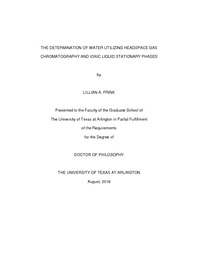| dc.description.abstract | Water may be the most analyzed compound in the world. It is measured, monitored and controlled in many industries and most consumer products. The moisture is regulated in products intended for human/animal consumption (e.g. foods, additives, and pharmaceuticals) since the presence of water can lead to the growth of microorganisms, molds, and spores which cause many diseases. In addition, water can affect the functionality and lifespan of other consumer products. The presence of moisture in petroleum products reduces it caloric value and flow properties. Water can interact with salts present in the petroleum and corrode pipelines and machinery decreasing their lifespan and structural integrity.
Over the past 80 years Karl Fischer Titration (KFT) has been the leading method to determine the moisture content in samples. This method however required knowledge of water content and structural information about the analyte and its matrix in order to utilize the proper sample size, additives, and titration cell type. Moreover the presence of a thiol, ketone, aldehyde, amine or siloxane functional group on the analyte or matrix can lead to interactions with the iodine titrant causing an artificially higher measurement of the water content. KFT is slow, labor intensive and some compounds have solubility issues which leads to additional sample preparation.
During the past five years, my research focused on the development of a new analytical method for the quantification of water in diverse sample types, encompassing a wide range of water content. The utilization of headspace gas chromatography (HSGC), ionic liquid GC columns, and a duel detector system produced an easy, rapid, accurate and precise method. The resolution of water from all other components found in various raw materials was obtained on three novel ionic liquid GC stationary phases. These were recently commercialized specifically for the measurement of water. The two detectors utilized were a thermal conductivity detector (TCD) and a barrier discharge ionization detector (BID). Both are universal detectors, meaning they can detect virtually any compound, including water. The utilization of these two detectors allowed for a wide range of water concentration/amounts to be measured. A TCD was used for evaluating samples with higher concentrations of water (1% to 95%). A BID has a narrower working range, but is much more sensitive. Therefore, it was used for analysis of samples containing lower amounts of water and for the measurement of trace water content (0.001% to 15%). The overall result is that the method proved to be effective for samples with as low as 10 ppm (0.001%) to as high as 95% water content. An optimized fully automated purging system was created by changing from a gas syringe injection to a sample loop injection. Incorporating a HS-20 autosampler into the set-up allowed for the reduction of residual moisture in sampling vessels by a factor of 10. Additionally, significant improvements to both reproducibility and the limit of detection were realized. The accuracy of the final, optimized HSGC method was compared to other methods, such as weight loss on drying, refractive index, Karl Fischer titration, by use of standard reference materials with known water contents (obtained from the National Institute of Standards and Technology, (NIST)). Standard addition was performed when feasible to verify the accuracy of all calibration curves. Relative standard deviations were investigated; all were found to be less than 5%. The overall average relative standard deviation of ~3% indicates the method was precise. The method was successfully used to quantify the amount of water in active pharmaceutical ingredients (APIs), final drug dosage formulations (both solid and liquid) pharmaceuticals, food, petroleum and petrochemical samples. When the results from the newly developed ionic liquid HSGC approach was compared to the KFT the HSGC method was found to be faster more accurate, and more precise. The KFT often had adequate precision in producing inaccurate results. | |


